Royal Troon
An Open Championship course of long standing, the Old Course at Royal Troon gets little affection from GCA posters but I always enjoy my occasional round here as a guest of member George McPhee. I have to share with you the fact that I suffered an 8&6 drubbing to bring you these pictures, the manner of my drubbing being a stern reminder that if you fail to find the right place on the fairway the greens are very cleverly defended even if, at first sight, they appear to have little character. The early holes were played directly into the sun, so those photos are less than ideal. Have patience! They improve from the 7th. From that it is easy to deduce that this is very much an out-and-back layout, generally playing with the wind going out and into the wind coming in, making the back nine notably stern when the wind is strong.
Like Royal Liverpool, Troon is not immediately visually gripping. From the clubhouse or first tee there are no towering dunes in view, it all looks quite wide open and generous and the card suggests that a killing is to be made going out, and it often is by Open Championship contenders. At my humble level a silly misjudgement is usually punished by several dropped shots. The layout has been considerably altered over the years, although nothing too drastic has occurred since first I came here in the early 1980s: new back tees on many holes and a few extra bunkers. The early courses were the work of George Strath and Willie Fernie, with Braid alterations in 1923. The yardages I give are for the medal course which we played: 6641 yards par 71 standard scratch 73. For the Open Championship it is stretched to 7150 yards, the Postage Stamp being the shortest hole on the Open Championship roster, while the 6th, at 599 yards was for a time the longest (usurped by the 600+ 14th at St Andrews).
1st Seal 357 yards par 4
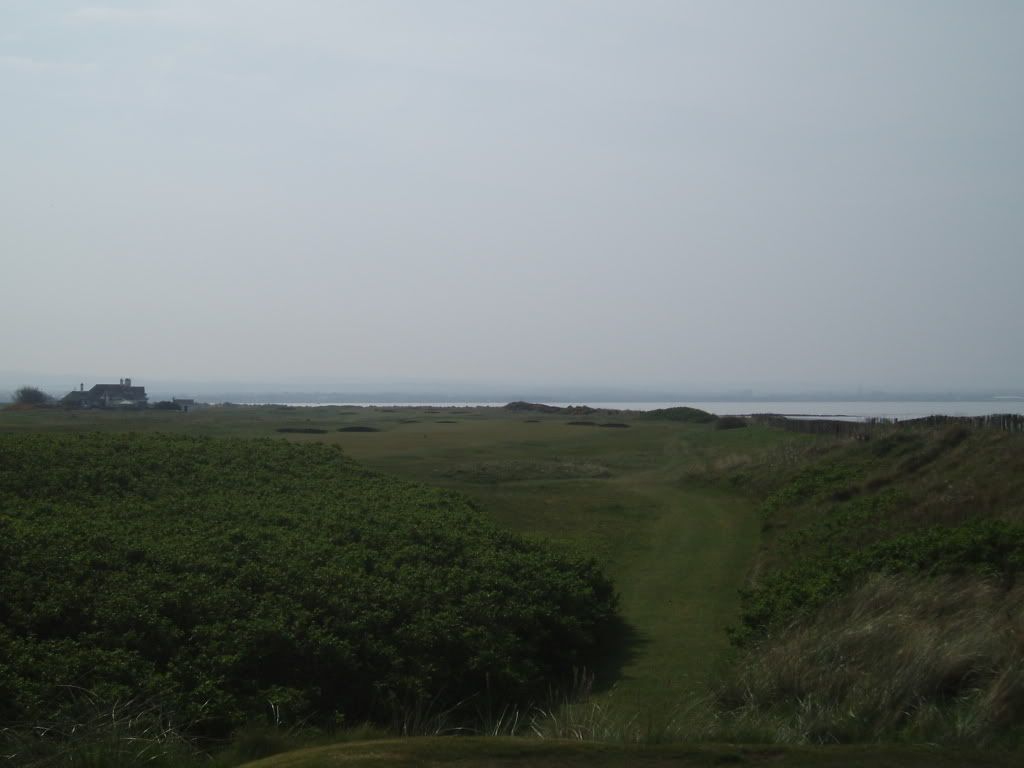
An opening drive along the shore line, well bunkered in the distance, but competent players can play safely with an iron and still leave a modest approach.
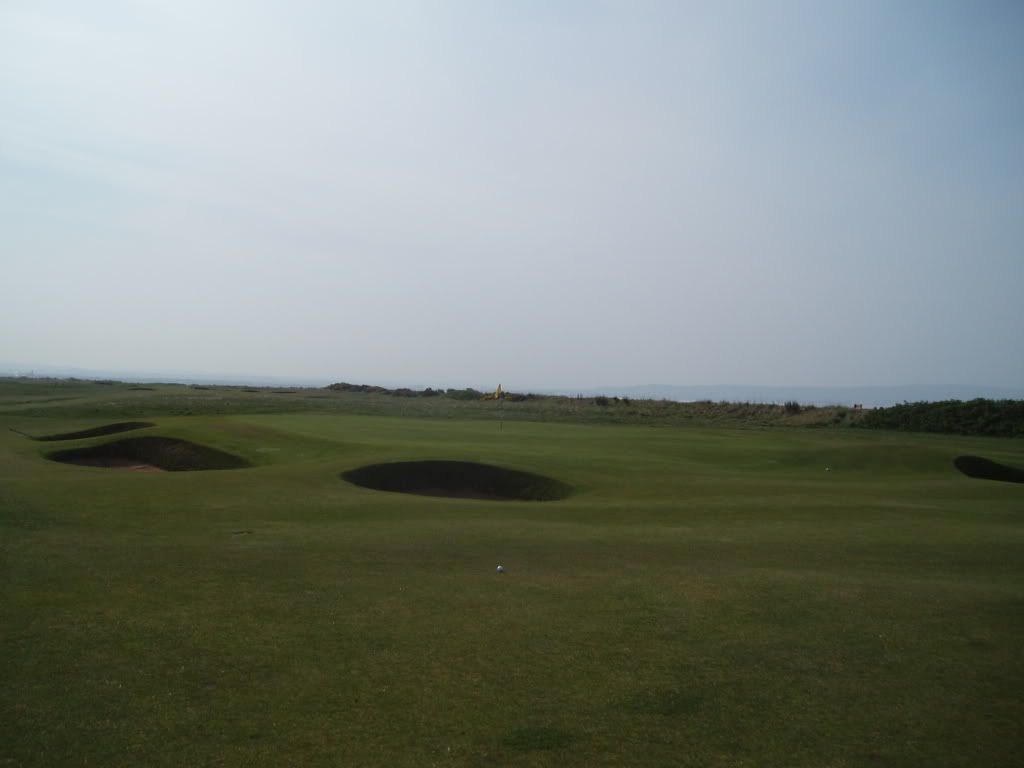
Stupidly, after an excellent tee shot, I have come up short and left, leaving a pitch over a bunker.
2nd Black Rock 381 yards par 4

The 2nd tee is also attractively sited beside the beach. You should have a fine view of the Isle of Arran from here, but haze blocked it out all day.

In winter the hole is played from a tee on the left of the fairway which very much brings all the bunkers into play. Again good players can take a safe positional iron from the tee. As at the 1st, good players may also attempt to drive the green if going for broke.
3rd Gyaws 371 yards par 4
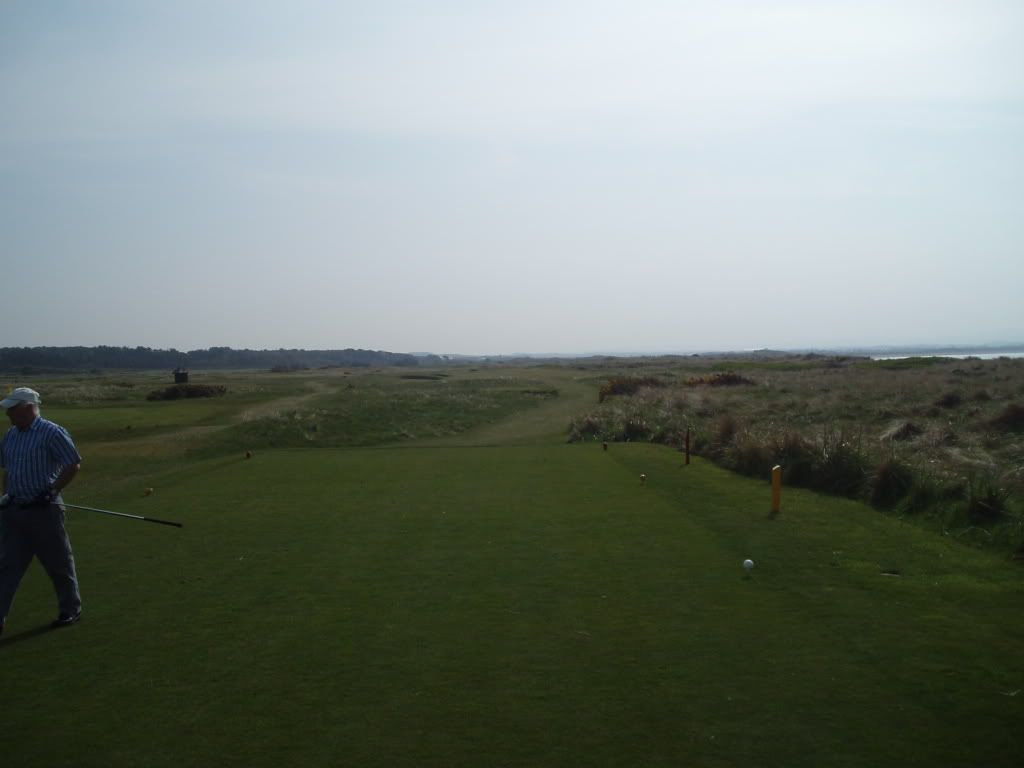
From the tee, the 3rd appears to be somewhat similar to its predecessors. What makes it different is:
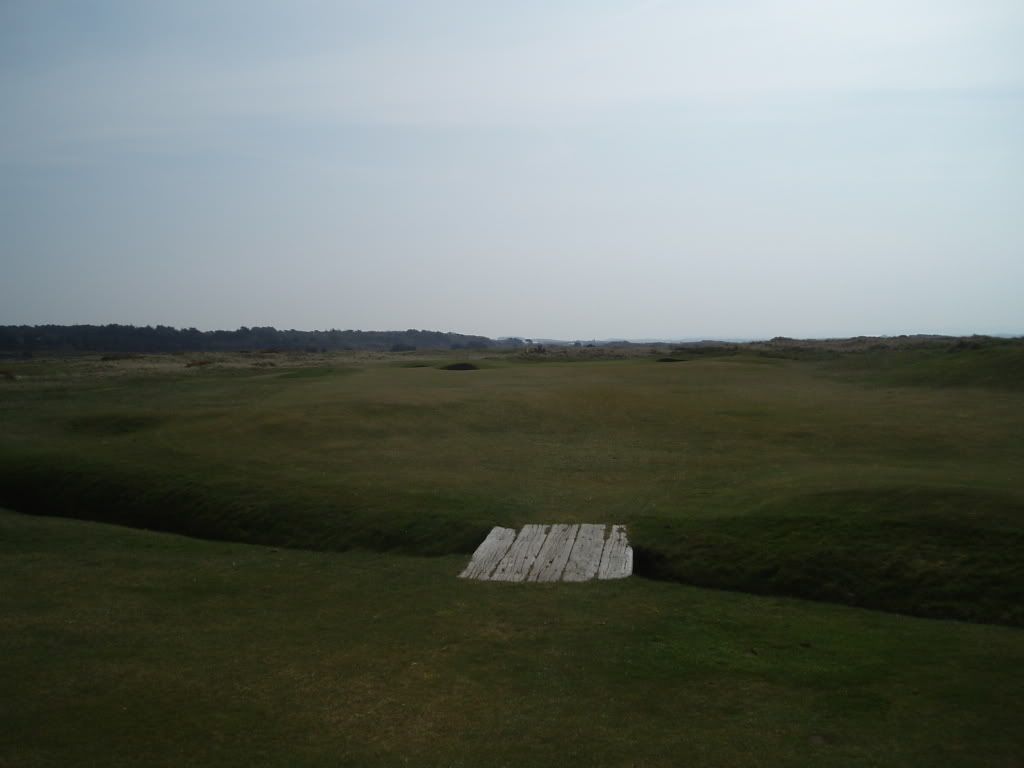
The Gyaws burn, invisible from the tee, crosses the fairway about 280 yards out and is an influence in clubbing for the good player.
4th Dunure 522 yards par 5
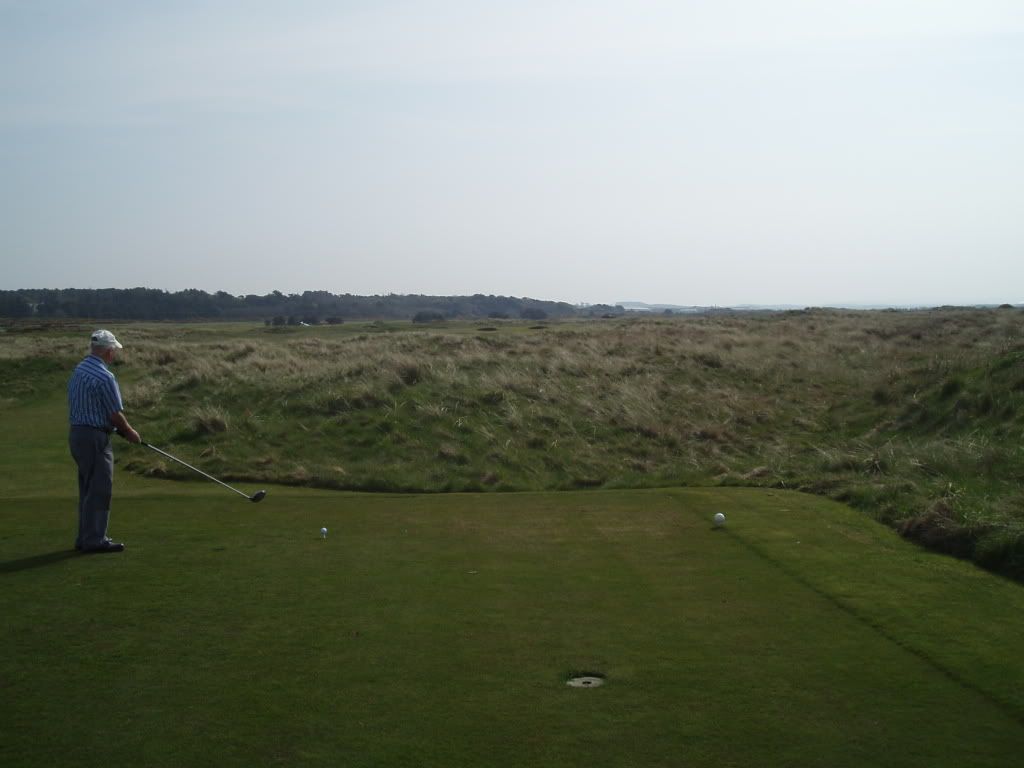
The first par 5 is a difficult driving hole for the higher handicap player because the fairway is slightly angled across the line from left to right and it is imperative not to try to carry too much rough in an attempt not to finish in either of the bunkers you can just make out in the distance. And there is also a sandy chasm on the right, invisible from the tee.
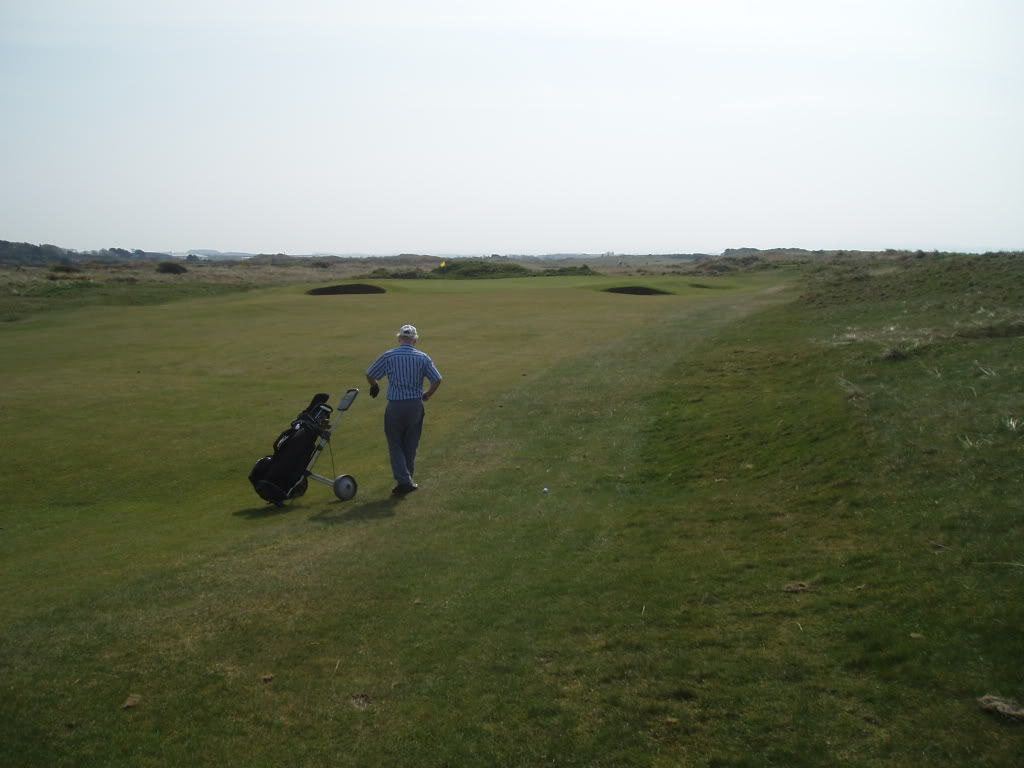
This is quite a narrow fairway with some fairly hostile rough off to the left. George has placed his second shot perfectly leaving an open approach to the day’s pin position.
5th Greenan 194 yards
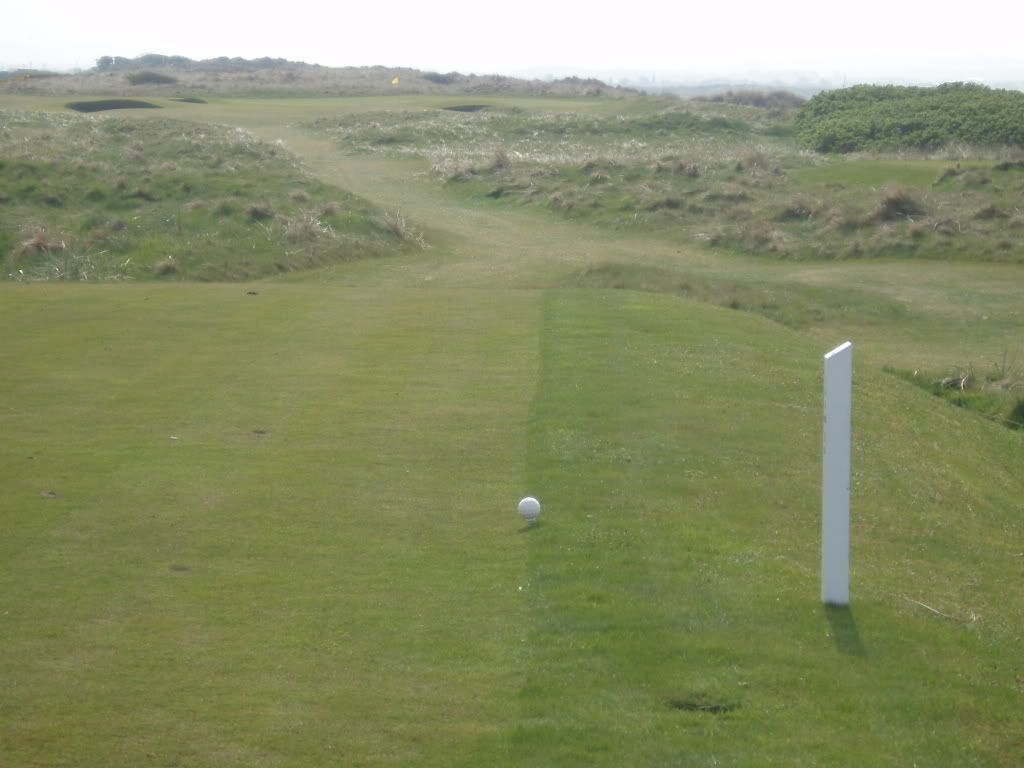
You climb on top of the dunes for this charming par 3, with fine views to sea out to the right.

We old-fashioned golfers who cannot stop a ball on the green must land short of the green and run the ball on. Frequently we misjudge it!
6th Turnberry 544 yards par 5

It is somewhat less claustrophobic from the more forward tees than it is from the very back, when the narrowness of the fairway becomes almost oppressive. In summer the rough is very grasping, that on the dune on the right particularly so.

Again I am out of position on the right with a testing approach shot to be played over that right-hand bunker to a raised green.
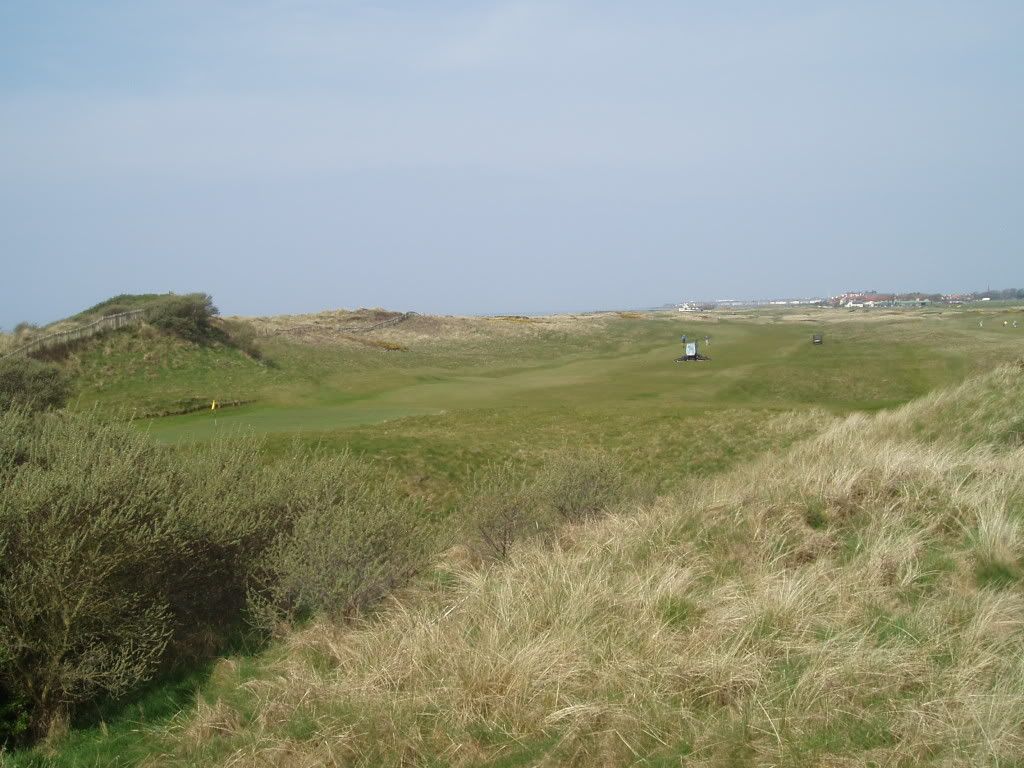
With the light behind, this suddenly looks a far more attractive hole.
7th Tel-el-Kebir 381 yards par 4
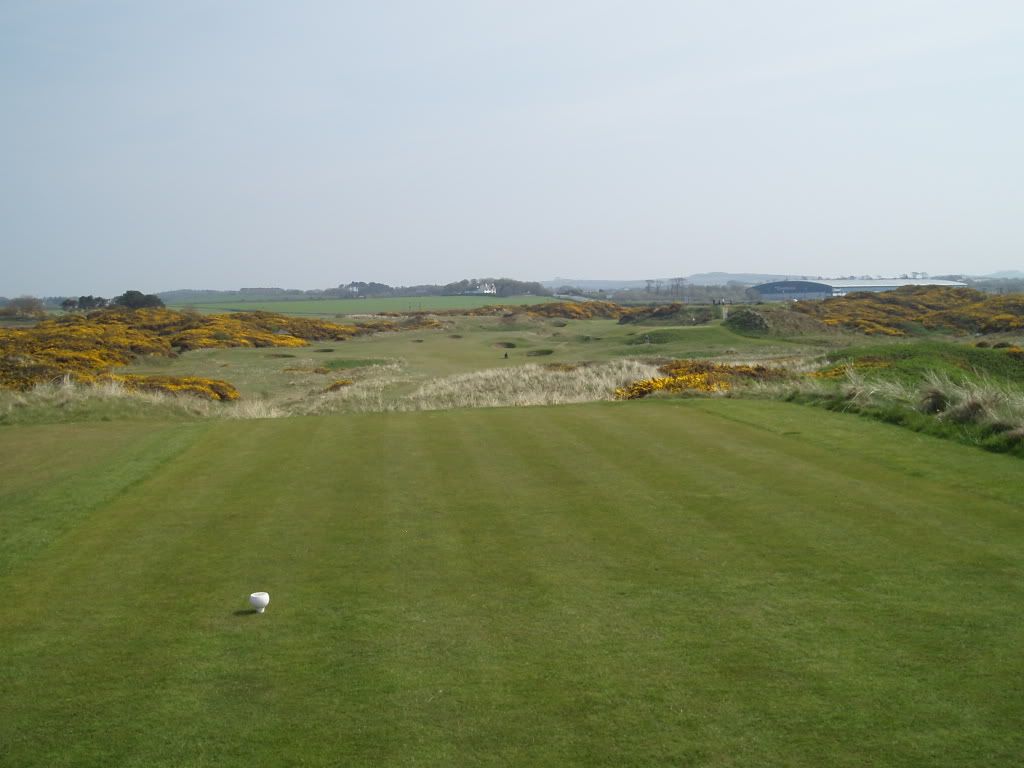
One of my favourite holes, the 7th turns inland, playing from an elevated tee to a heavily-bunkered dog-leg hole. Unfortunately Prestwick Airport makes its presence felt, the 4-ball to the left of the hangar standing on the 8th, Postage Stamp, tee. Its raised pimple of a green is visible beneath them. The 7th green sits in a gap in the dunes beyond it and to the left as we look at it.
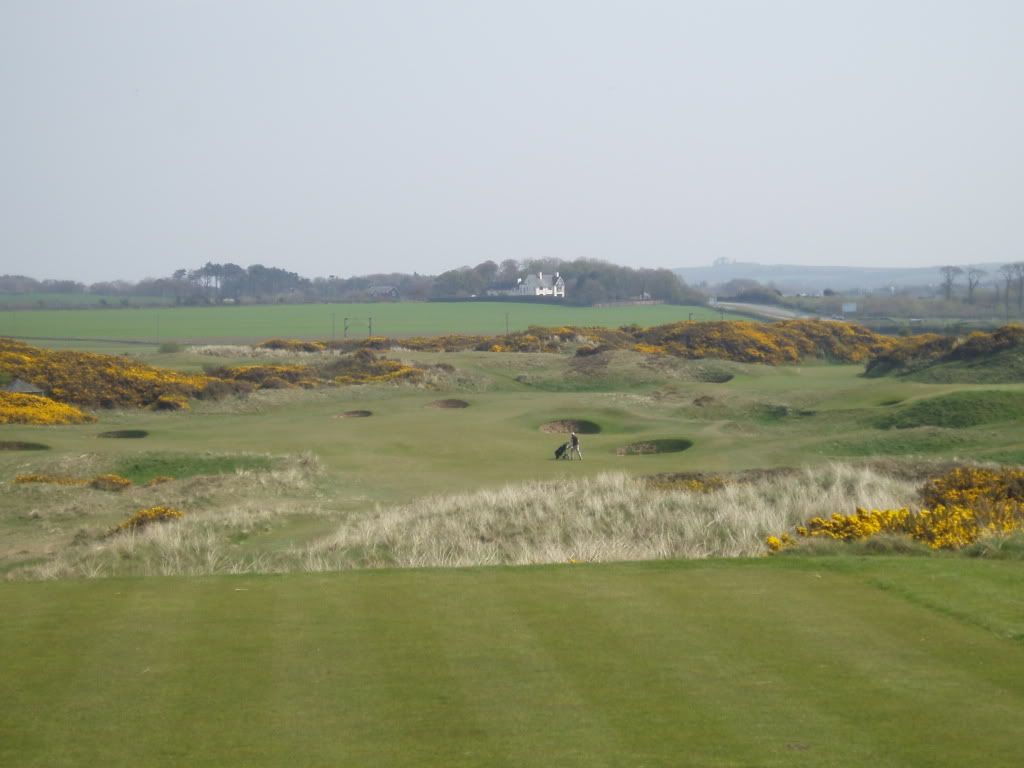
A closer view, with the green now just discernible on the right backed by a huge bank of gorse (which is actually on the right of the 10th hole).
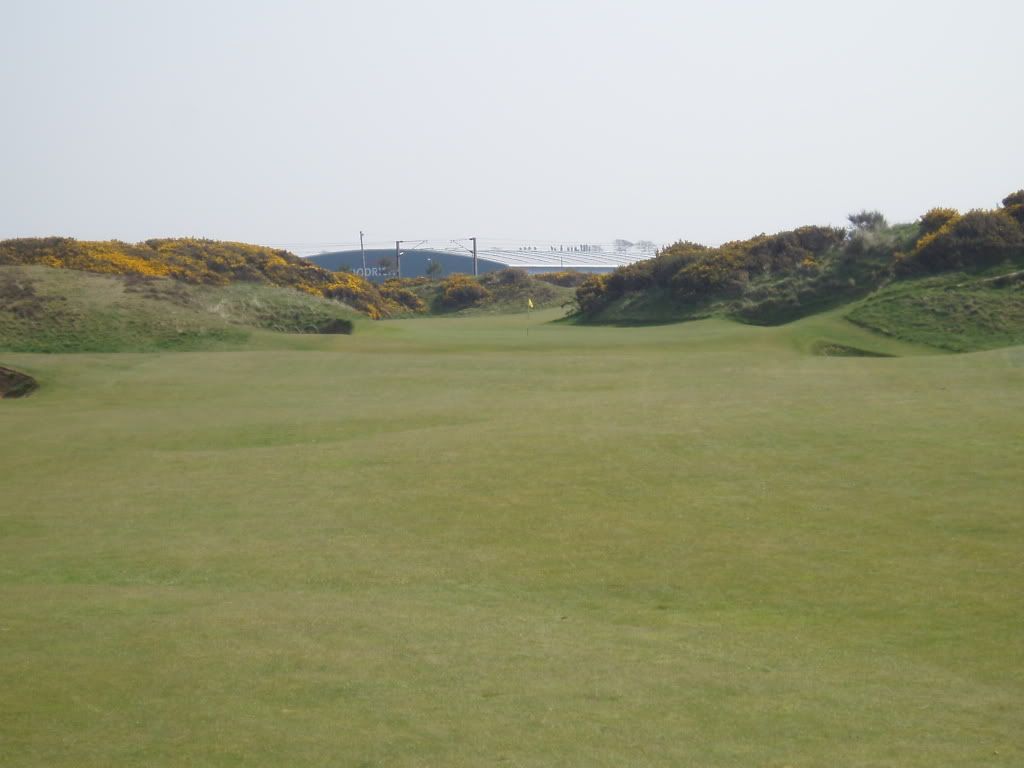
The green is guarded by a considerable dip in front, deep bunkers to left and right front and a really nasty, narrow bunker on the right of the putting surface beyond the right hand bunker that we can see.
8th Postage Stamp 123 yards par 3
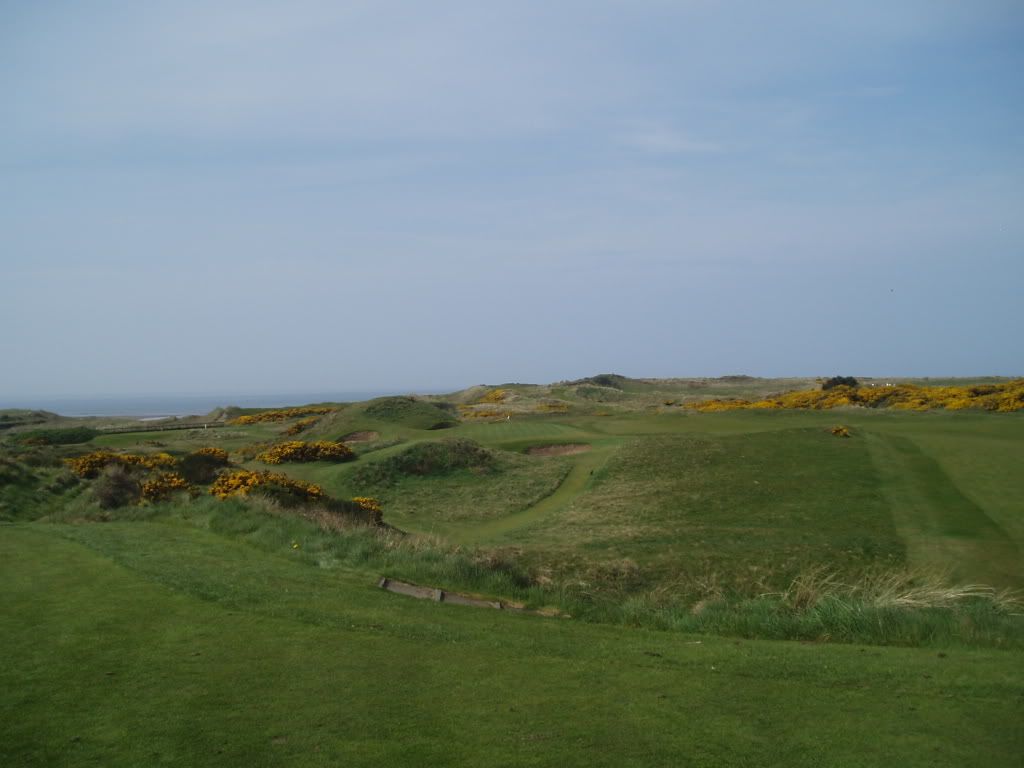
One of the most famous of all short holes. More or less directly over the left hand bunker and the left hand slope of the mound is the winter green! You cannot see it, in its punchbowl setting, and the penalties for missing are at least as severe as for missing the real Postage Stamp. I have played it several times and I cannot find any love for it. George was relieved that we were playing the normal hole – it is not so unfriendly!
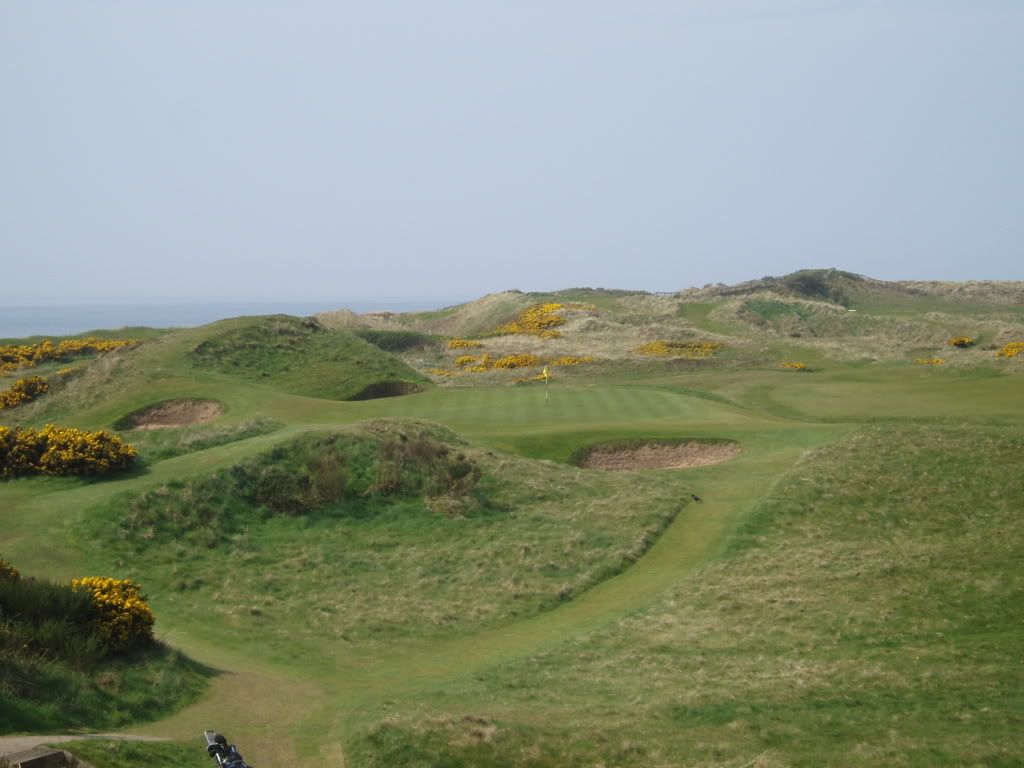
A touch of zoom shows the hole in clearer detail. Notice that little horror of a bunker left of the putting surface.
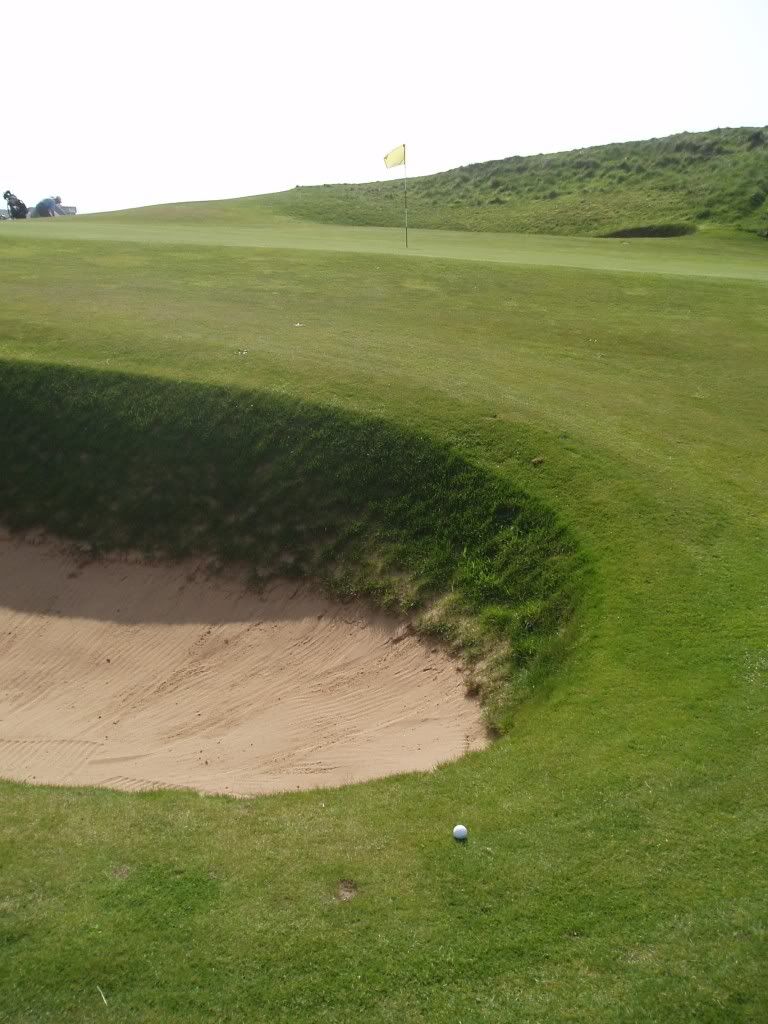
My tee shot hit the right edge of the putting surface but it slid off to the right, finishing here. I was lucky. Poor George is raking his bunker having had no alternative than to come out backwards and still have no shot to the green!
9th The Monk 387 yards par 4
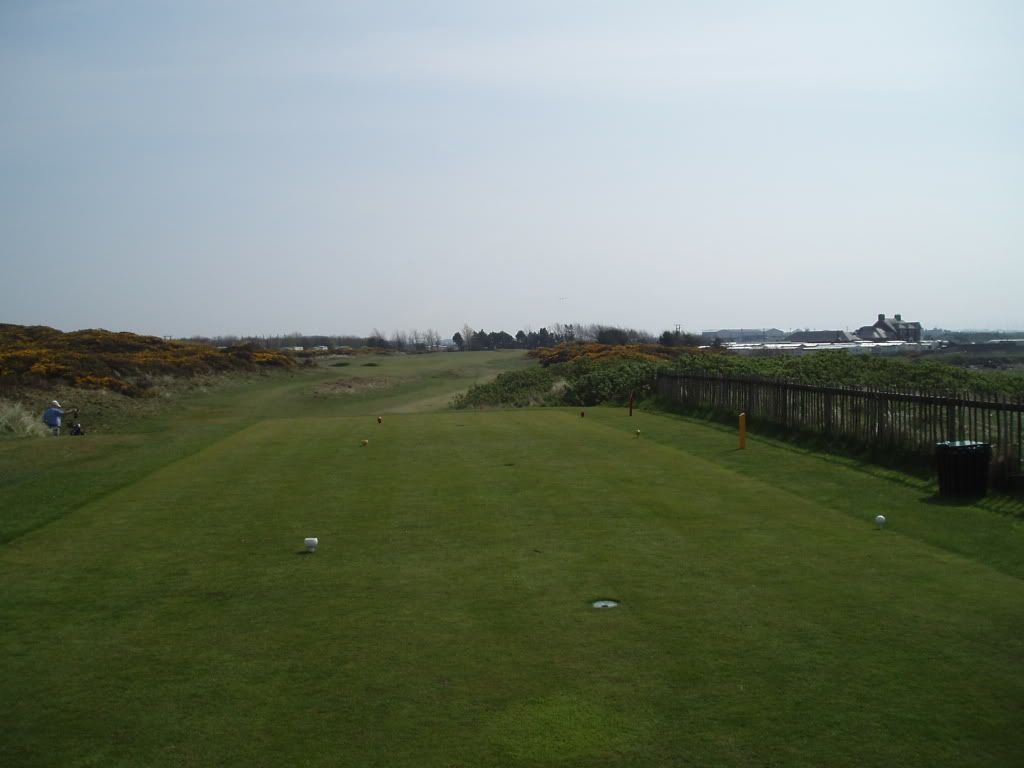
This is far from my favourite hole, partly because of the ghastly caravans which spoil the view, but also because I have never played it well. The ideal drive needs to flirt with those two bunkers on the left, yet instinct suggests trying to find the fairway to the right of them. From the right the approach is fraught with danger.

You can see a little of the deep gully on the right with which you may well tangle if you do not drive close to those bunkers. Worse you may well perish in the nasty gorse bushes which line the right of the fairway only just off the approach line. Coming in blind over the hummock on the left is nasty, too. (The green used to be behind that hummock, left of the present green). I am here in two, ideally placed if not actually on the green, but that pin is on the shallow upper level and the back of the green falls sharply down to long grass and weeds from which escape is uncertain. The horrendous backdrop makes distance judgement difficult from afar even if the sprinkler heads all carry yardages to the front of the green.

It is a much more handsome hole looking back. On the left, very visible, is the treacherous bank of gorse lying in wait for those approaching from the right of the fairway.
10th Sandhills 385 yards par 4
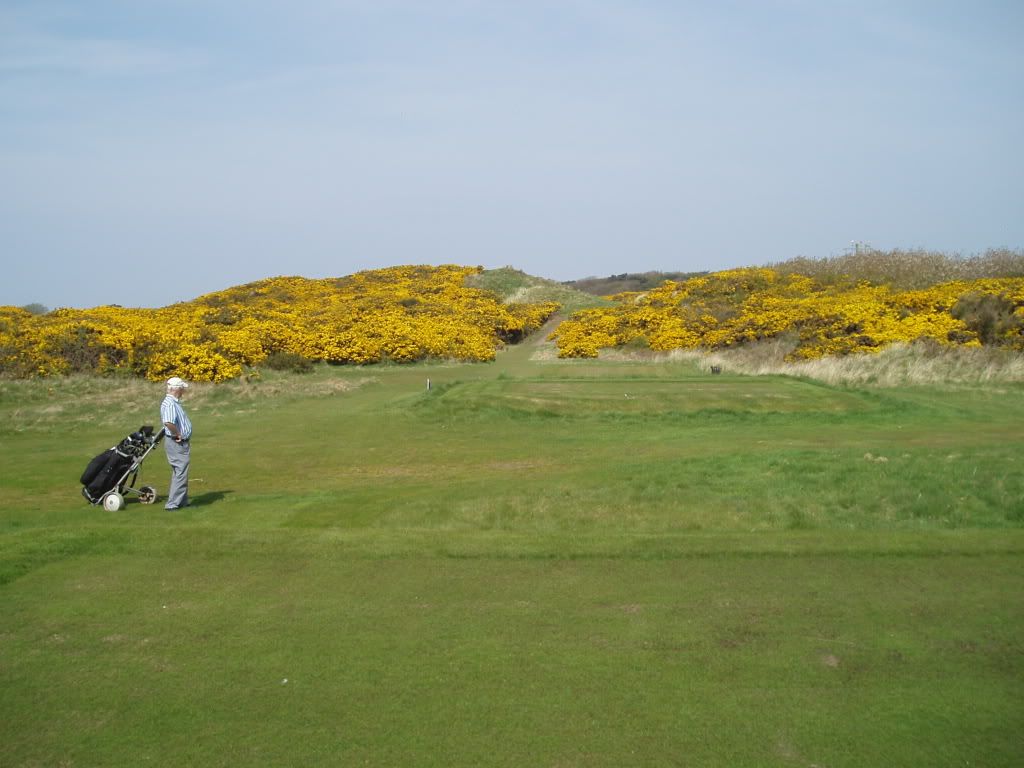
Open Championship competitors must play from here over that gorse-clad hill to a right-to-left angled fairway with plenty of trouble (gorse and deep depressions) if you go through the fairway. The men’s winter tee is that you can see in front. I do not like it from down there.
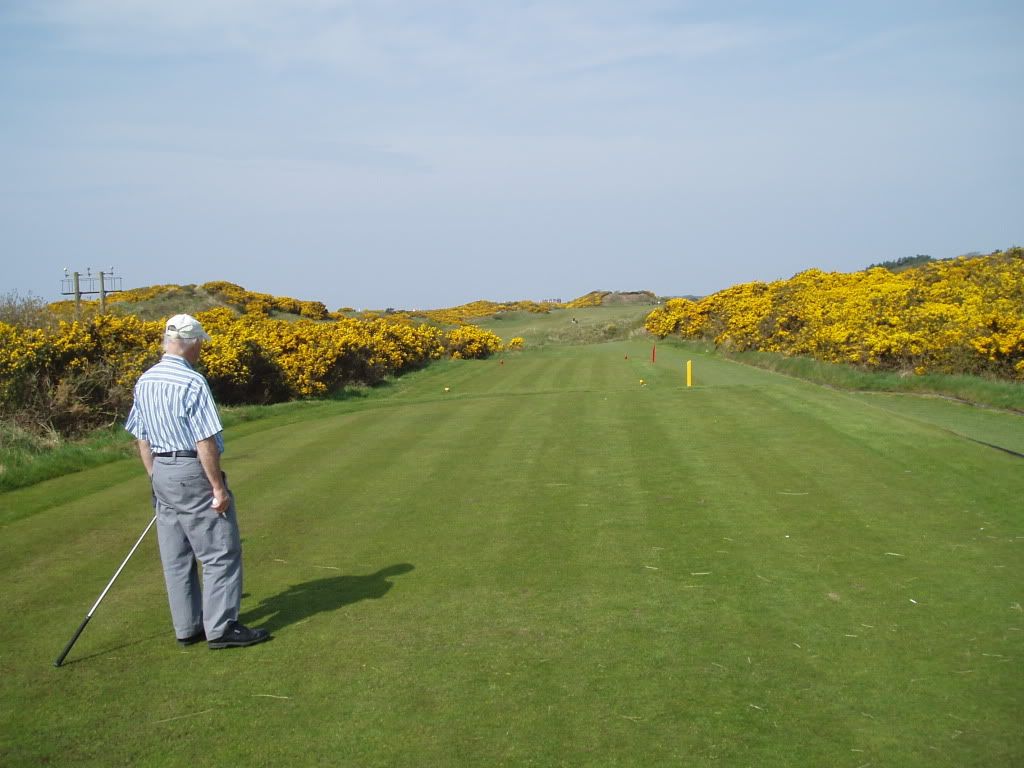
From the medal tee, however, the view is inspiring (apart from the airport approach lights). The direct line is not the one to take, with umpteen depressions to trap the unwary and the likelihood of bouncing right and into the gorse.
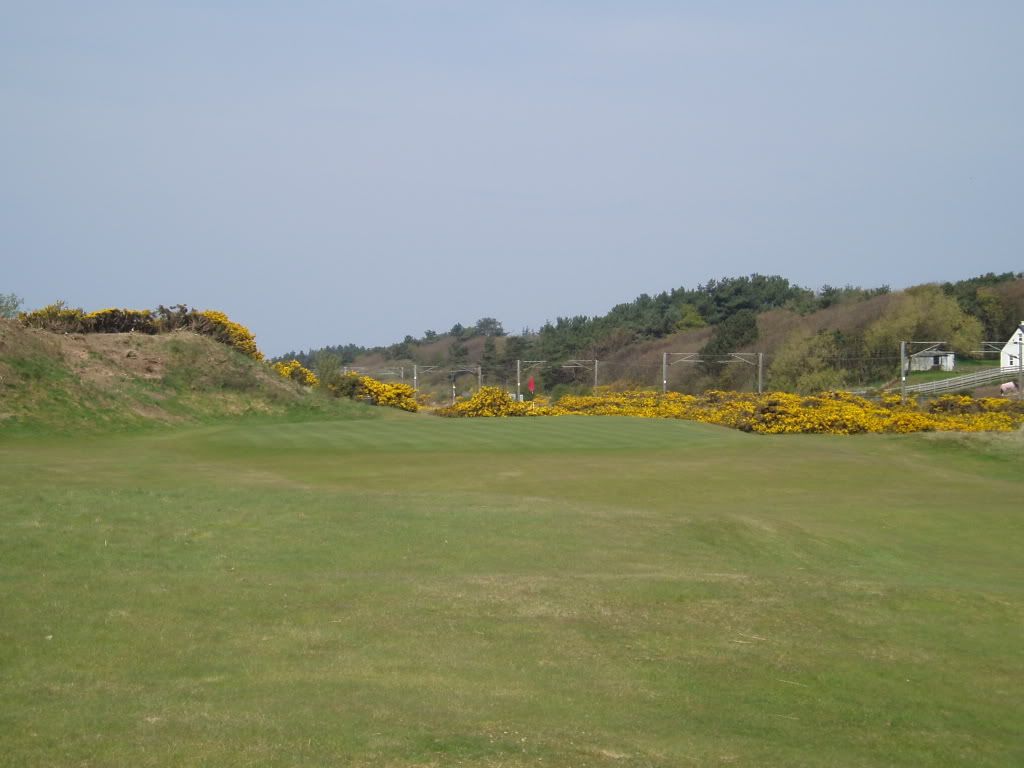
The approach shot is made to a hill-top green, domed in such a way as to repel all but the perfectly struck shot. It is a bunkerless hole in no need of bunkering.
11th The Railway 421 yards par 4
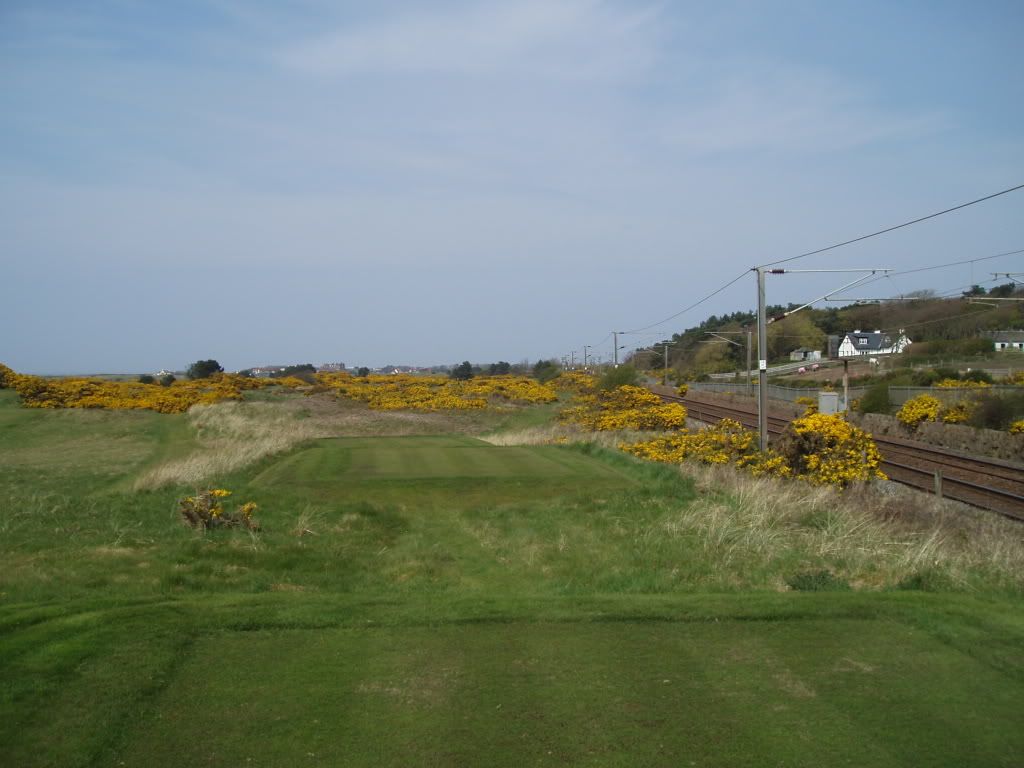
This is the terrifying prospect from the championship tee.
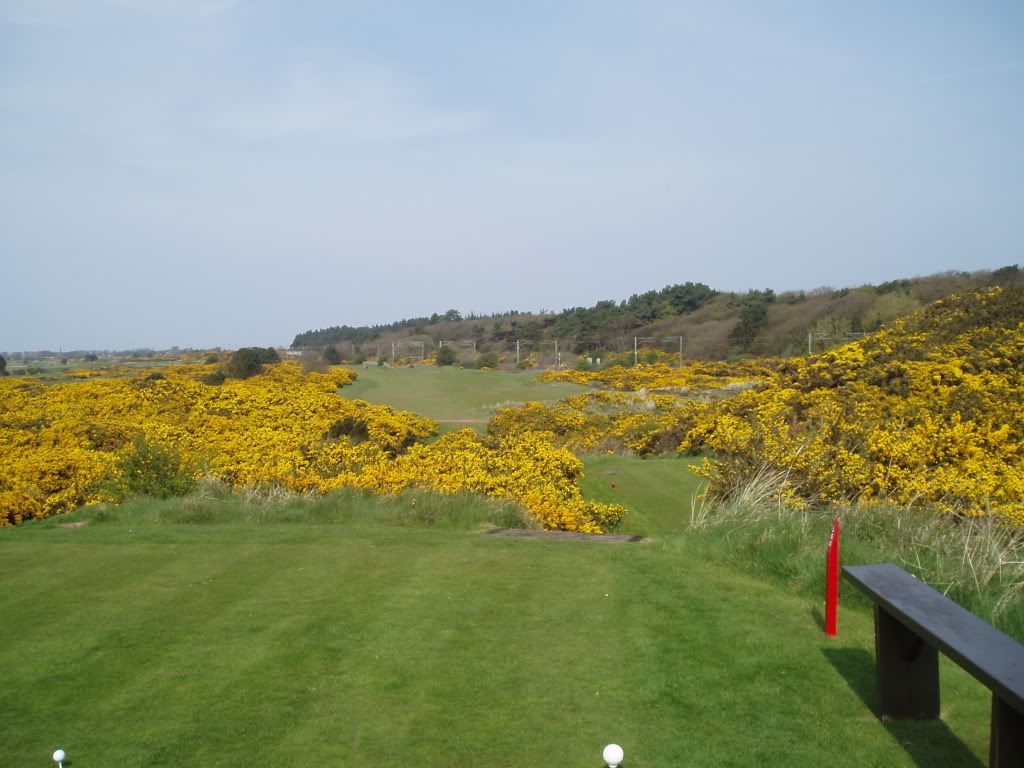
And this is the (nearly as terrifying) prospect from the medal tee. At least from this tee you can see the gorse bush in which your drive perishes. Note, also, that those gorse bushes on the right of the hole cannot be seen from the championship tee. You cannot just line up parallel to the railway!
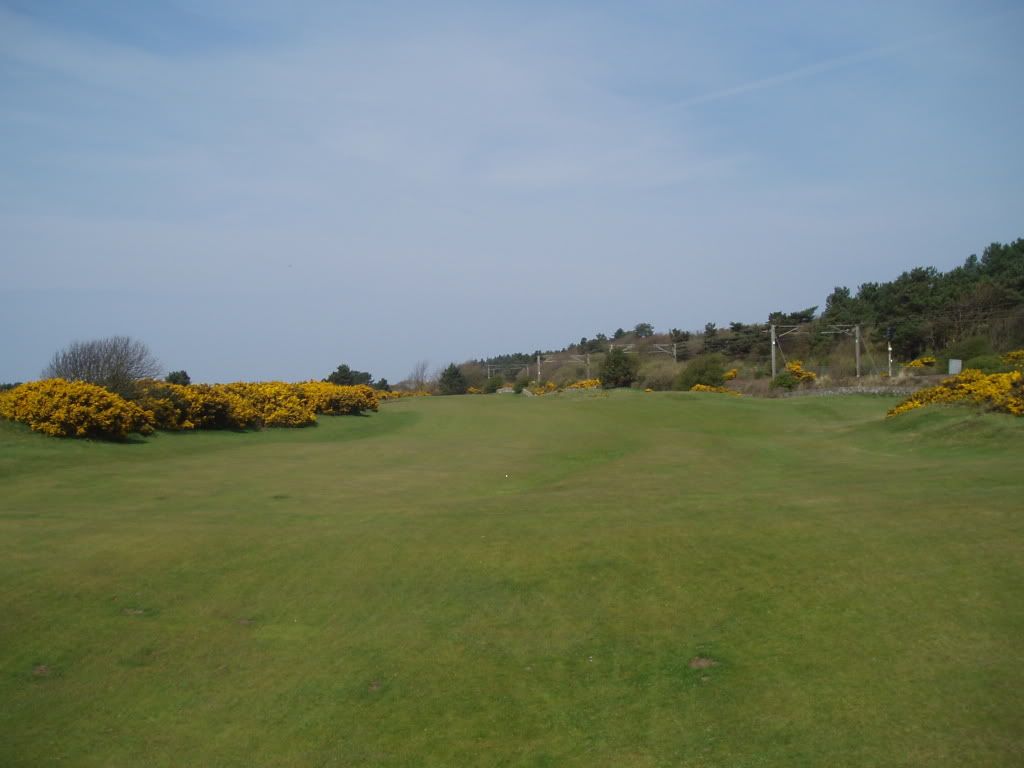
The green lies ahead right up against the wall alongside the railway line. It is a white-knuckle moment.
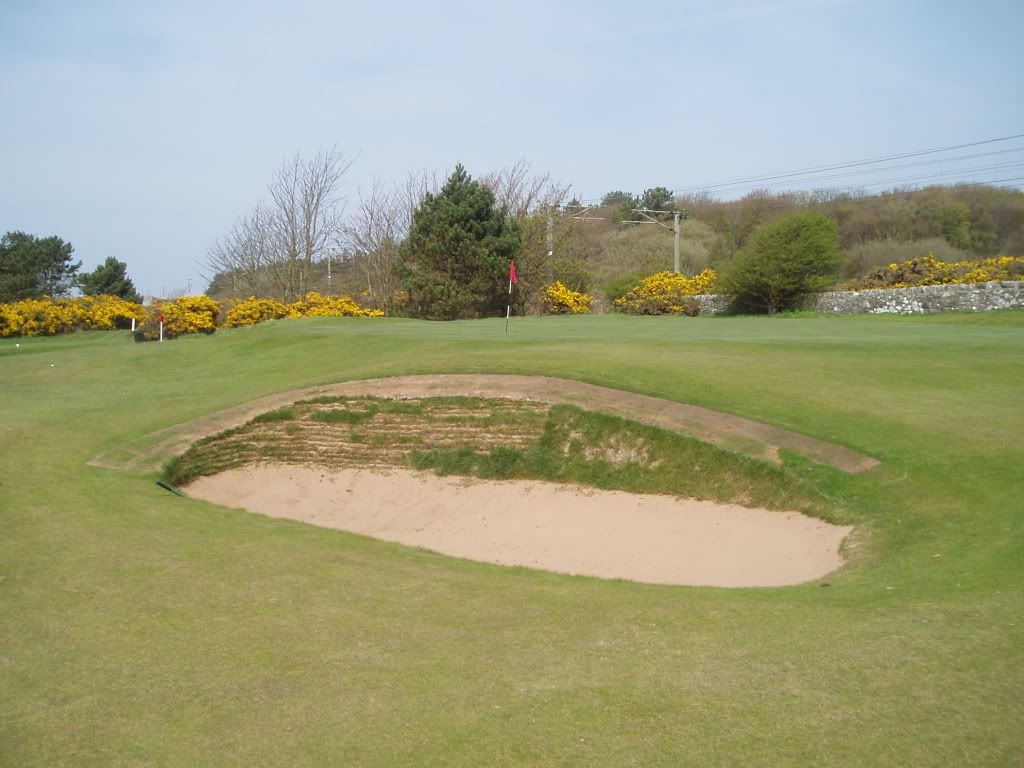
As a result many a shot is played to the left only to bounce down into this bunker or onto the low ground beyond, as I have done.
12th The Fox 421 yards par 4
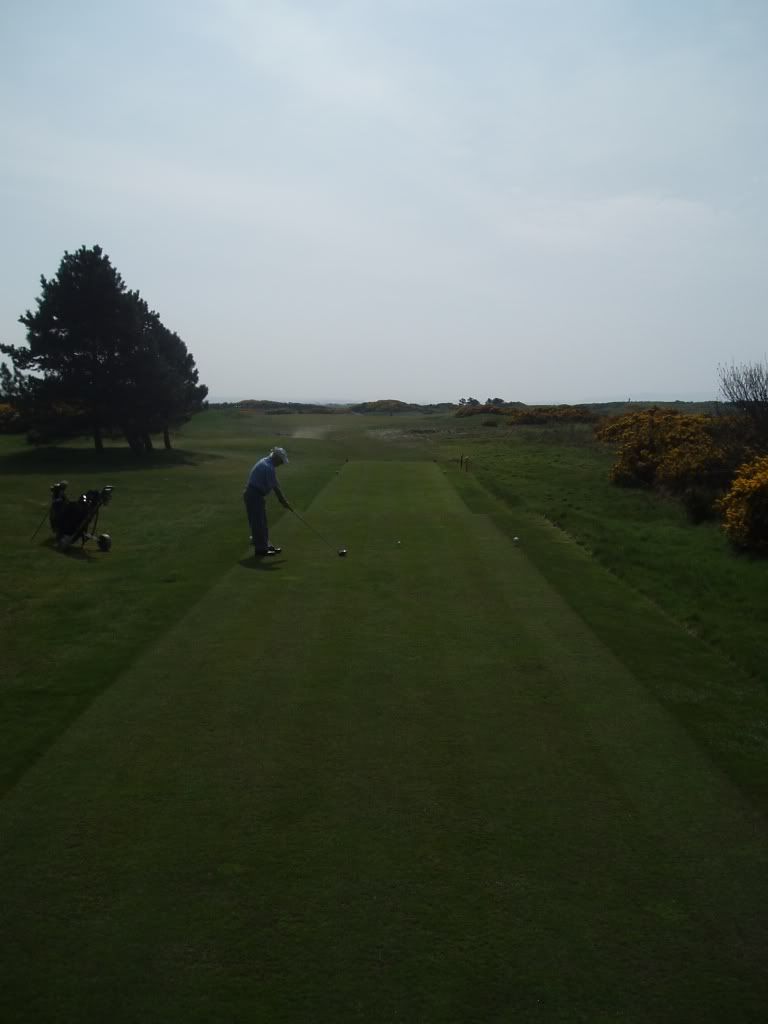
For one hole the course turns back, and in this case into the sun. It is not the hardest par 4 and a good drive can take advantage of a fairway downslope to gain many valuable yards. (Only a few years ago I managed to catch a drive out of the meat and enjoyed by far the longest drive of my life on this hole).
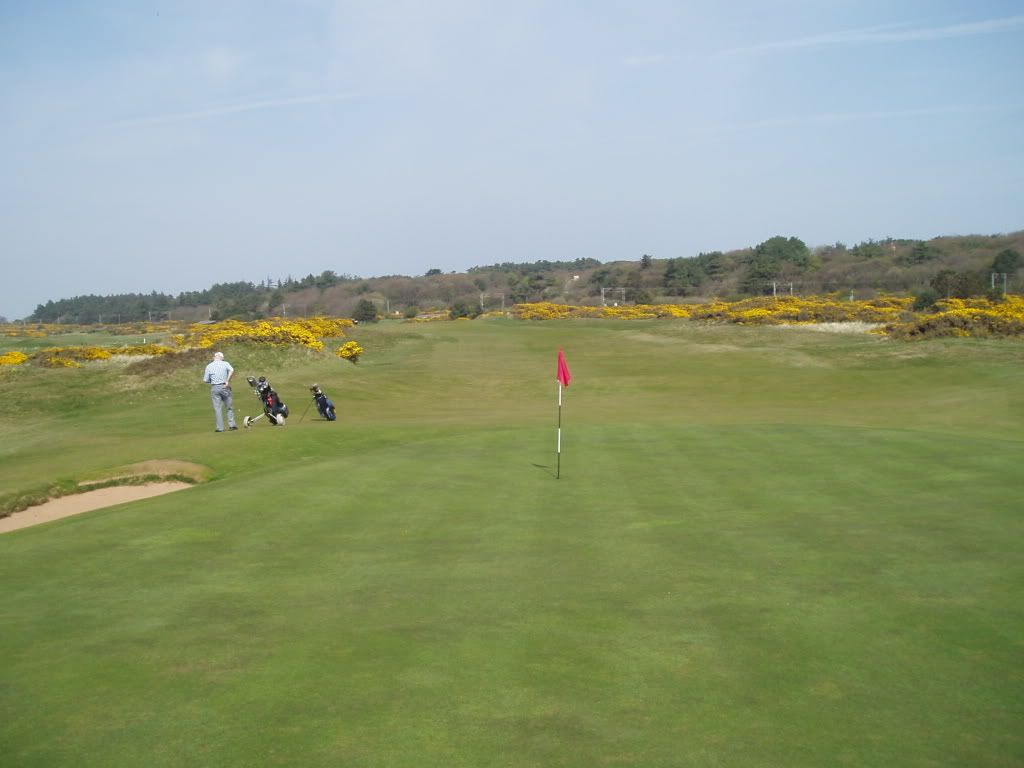
Looking back whence we have come. In 1989, in the final round, Mark Calcavecchia chipped into the hole from a nasty hanging lie on the left of the green (our right) to keep his Open Championship hopes alive.
13th Burmah 411 yards par 4
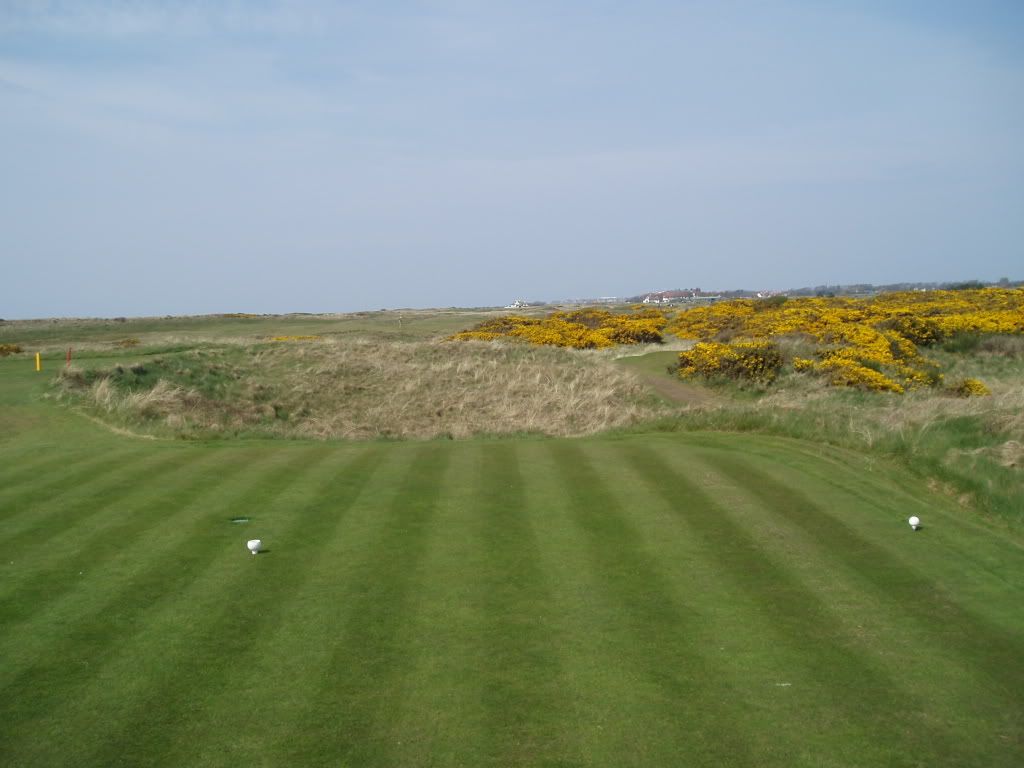
This is a difficult drive with the fairway angled left-to-right across the line. There is plenty of trouble on the right if you try to bite off too much. The championship tee is 60 yards further back, but it is elevated so the correct line is slightly easier to assess.
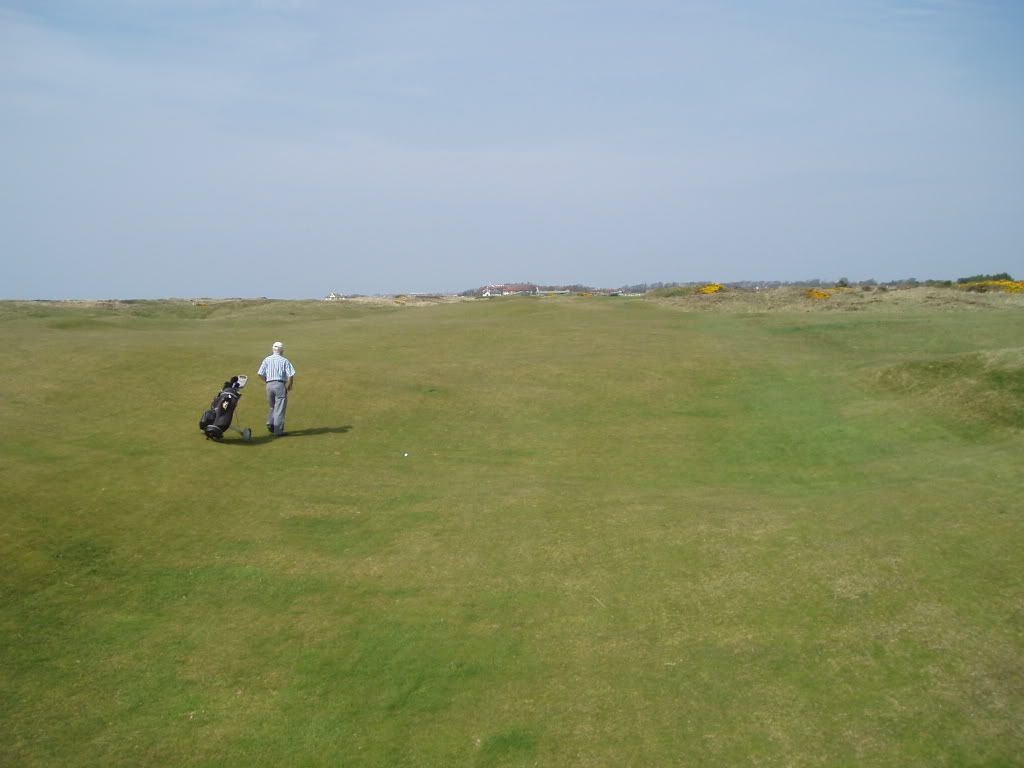
There is little in the way of feature to tell you where the green is on your second shot.
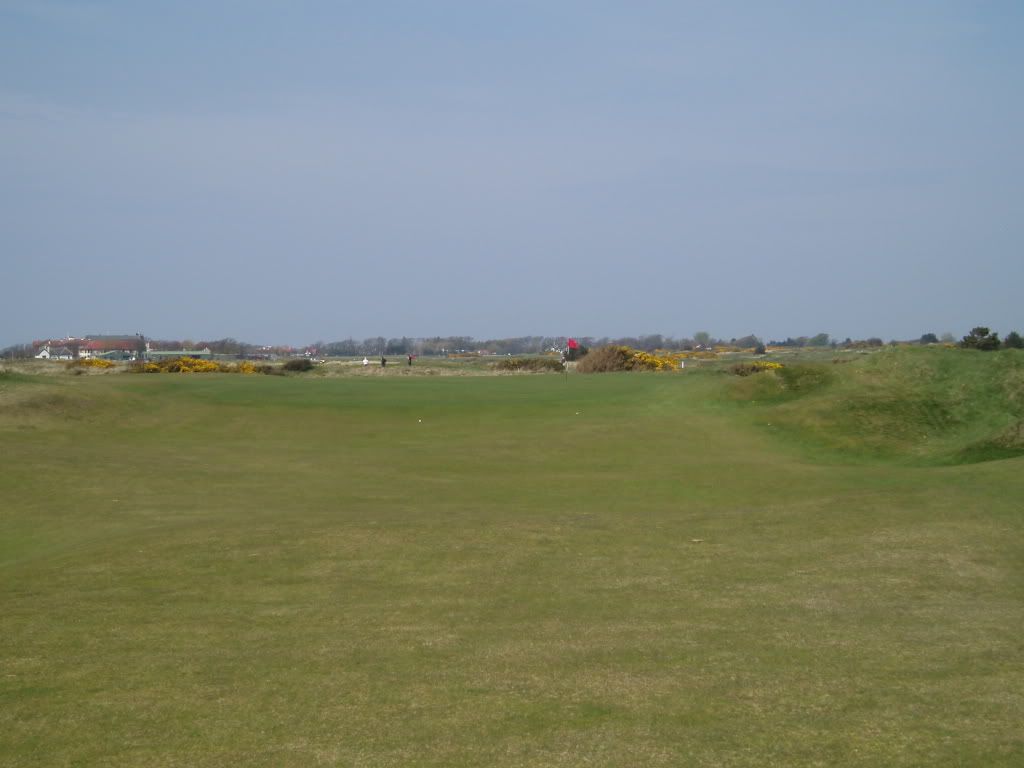
In fact the green is slightly raised up, just enough to stop many an approach shot making the putting surface. There are all sorts of little humps and hollows if you err to either side, and long grasses and gorse if you err more seriously.
14th Alton 175 yards par 3
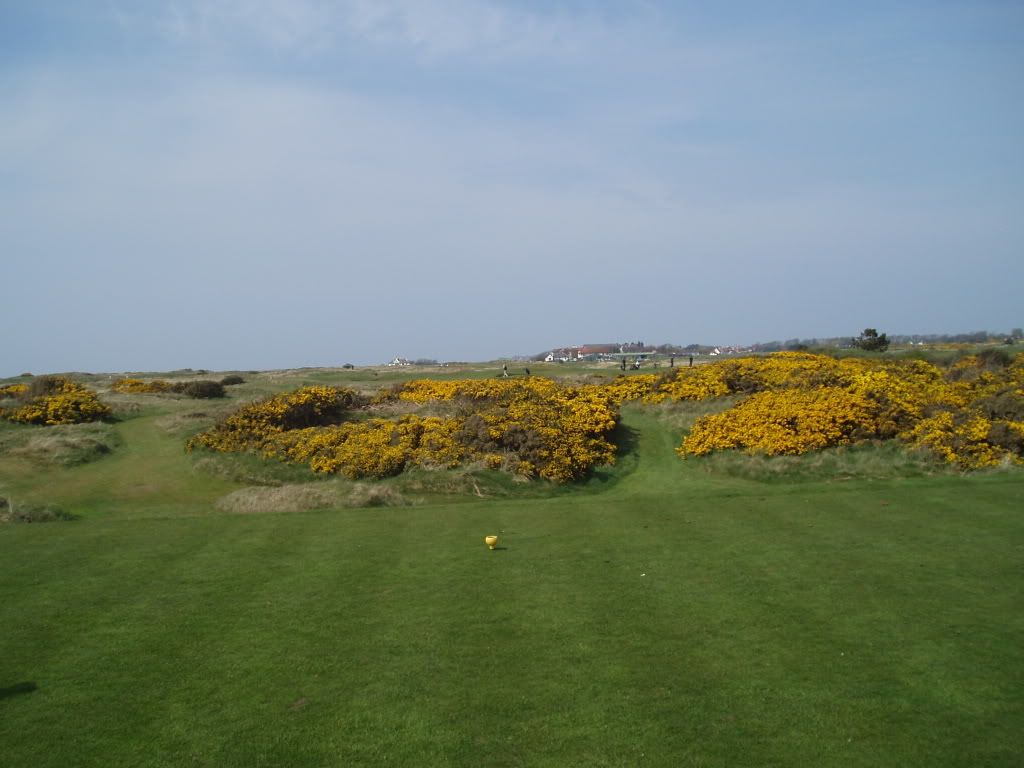
It is not entirely obvious where the green is, with a bank of gorse slightly obscuring the view.
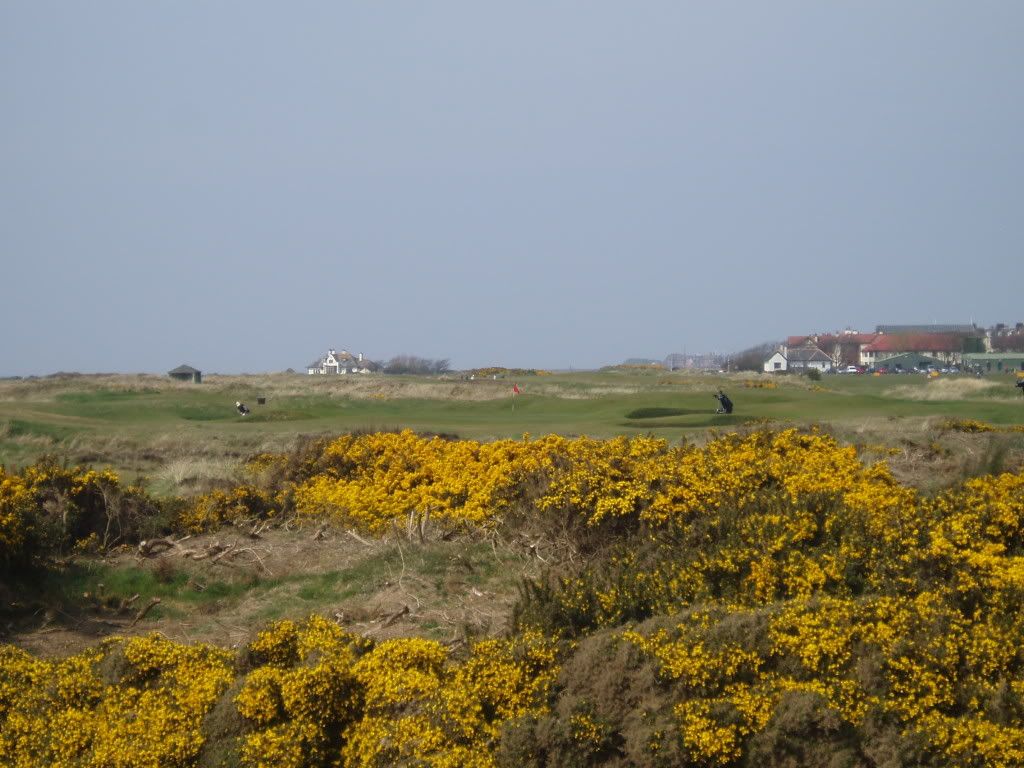
Moving forward reveals a little more. The golfer in front is a Troon Committee man. He is not in a sand bunker, but playing out of a grassy hollow.
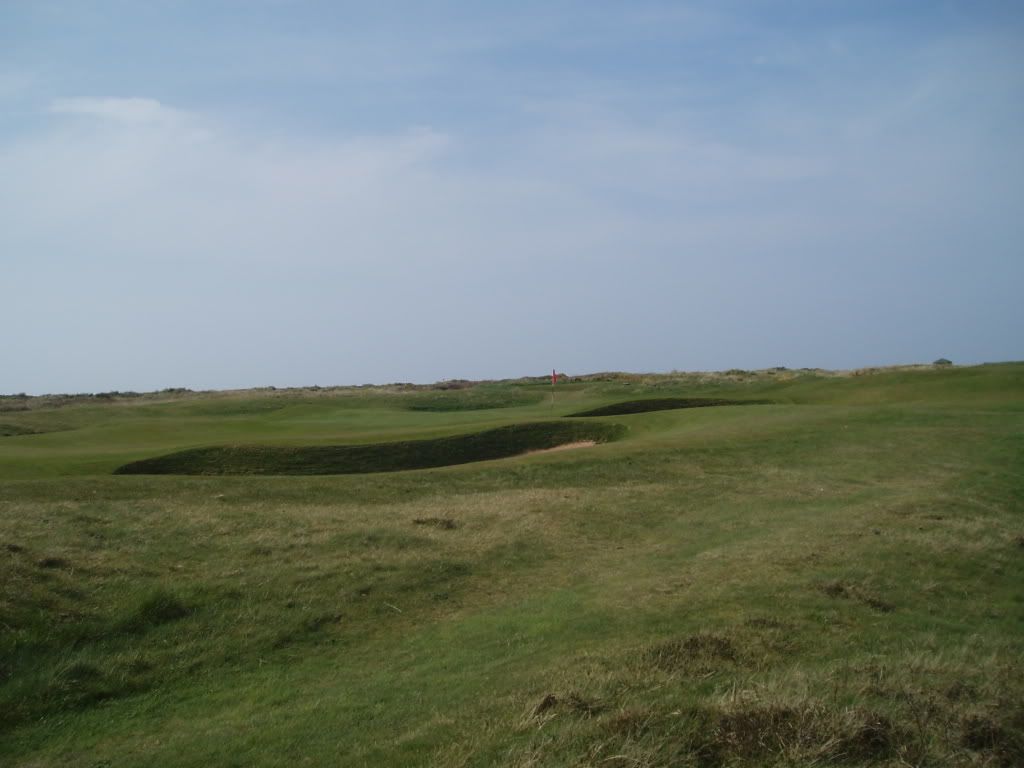
There are some tricky spots in these bunkers on the right of the green. Get too close to the face and you may well have to come out sideways.
15th Crosbie 455 yards par 4
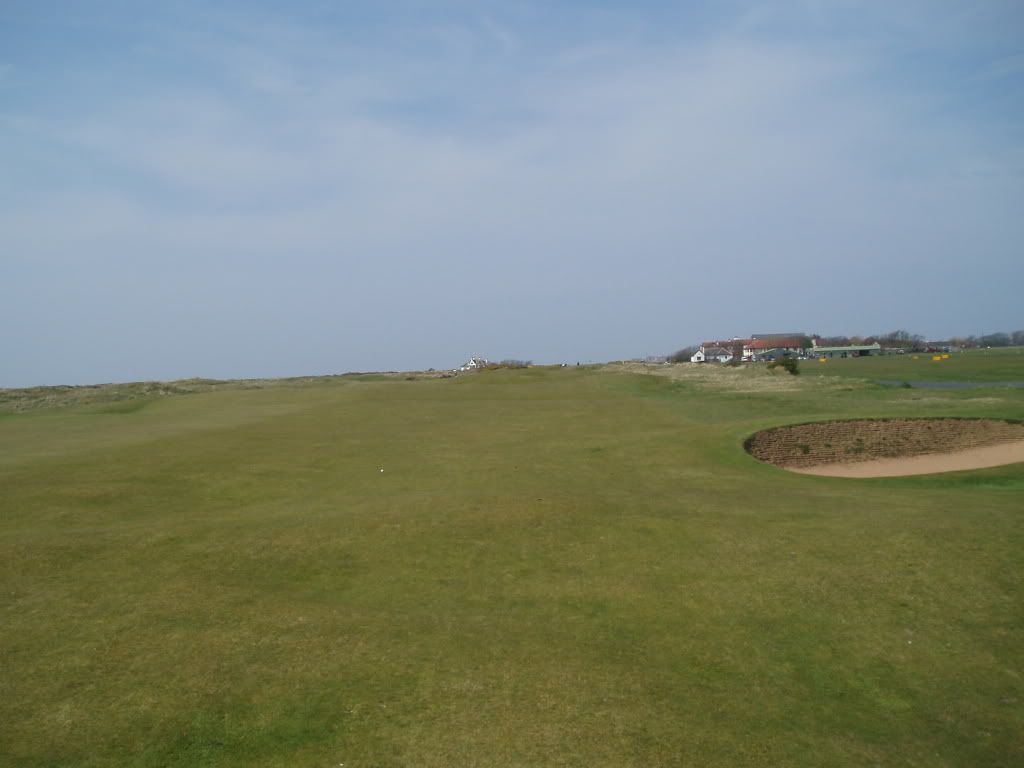
For some reason I neglected to take a photo from the tee. Here is the view after a decent drive. The medal tee is on the right of the 14th green, the drive being played pretty well straight down the fairway. The championship tee, however, is to the left of the previous green giving an angled drive into the fairway just where two bunkers on the left and this one on the right await. It is a brute of hole in a strong wind. The green lies just to the left of the distant house.

This time the secretive green is sunken down in an amphitheatre with a mound on the right and greedy bunkers on the left.
16th Well 533 yards par 5
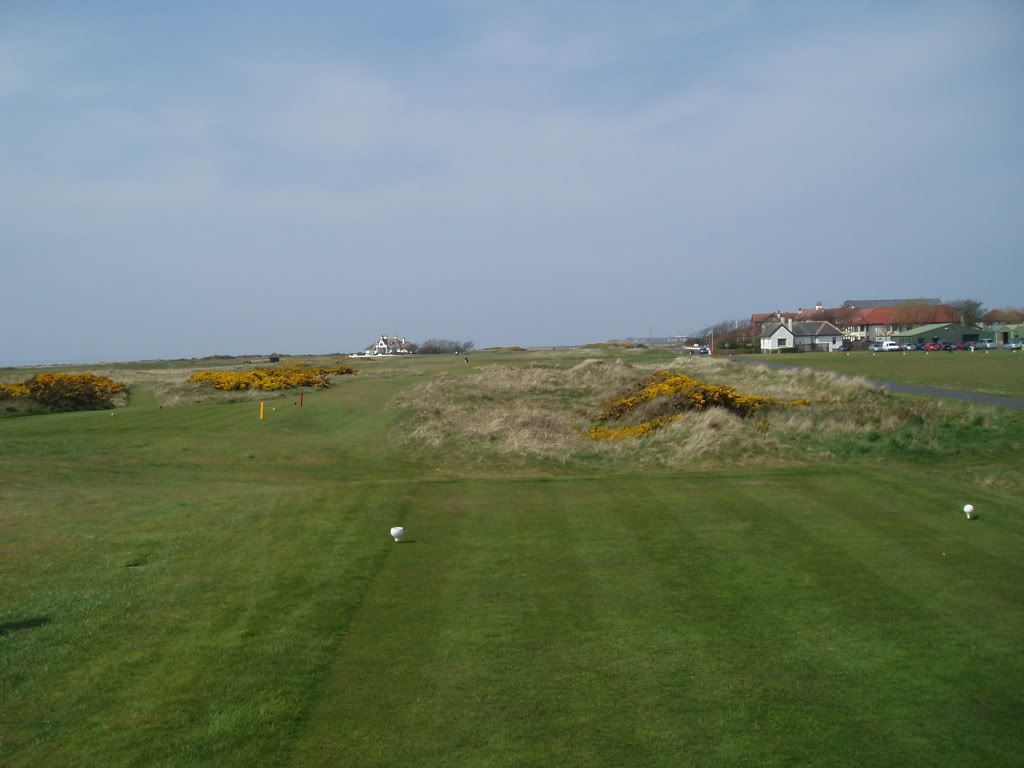
I don’t know what the stars of today make of this hole, because a burn crosses the fairway 283 yards out from the championship tee (which increases the hole length to 542 yards). For me it is the simplest drive of the round as I could never reach the burn, especially into the wind. That is the practice ground on the right, a car drive from the clubhouse.
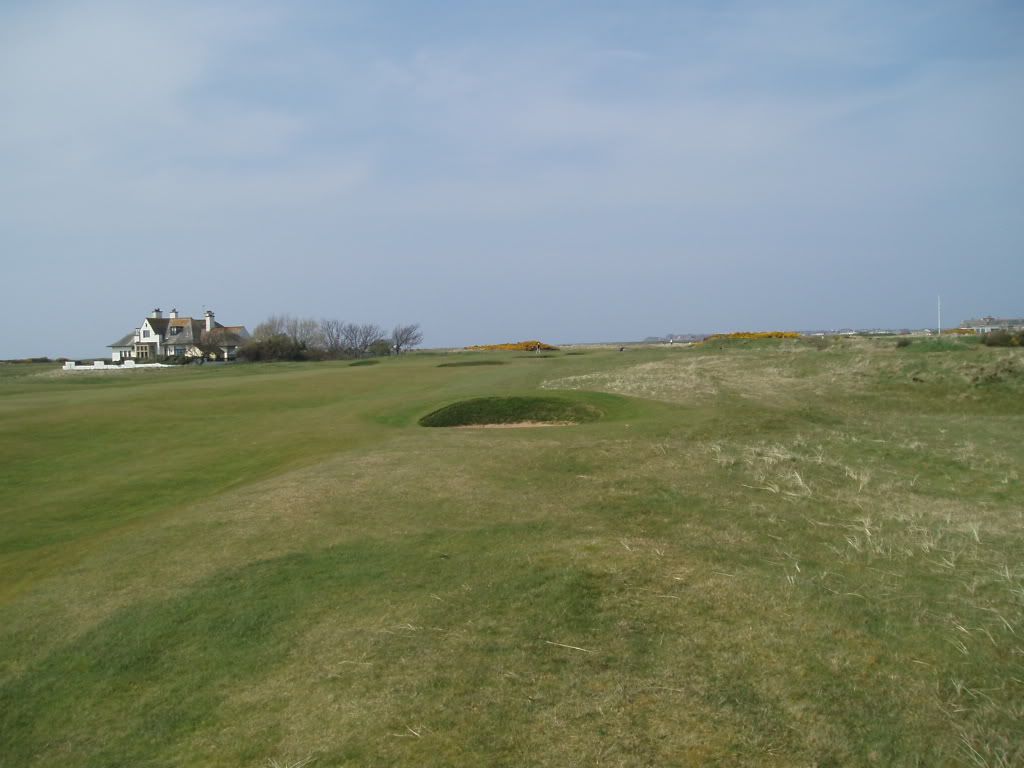
On the whole, unless you are Tiger Woods or Greg Norman who have reached this green in two shots, you are advised to play to the left of this fairway with bunkers more on the right than the left and they are not easily visible from afar.
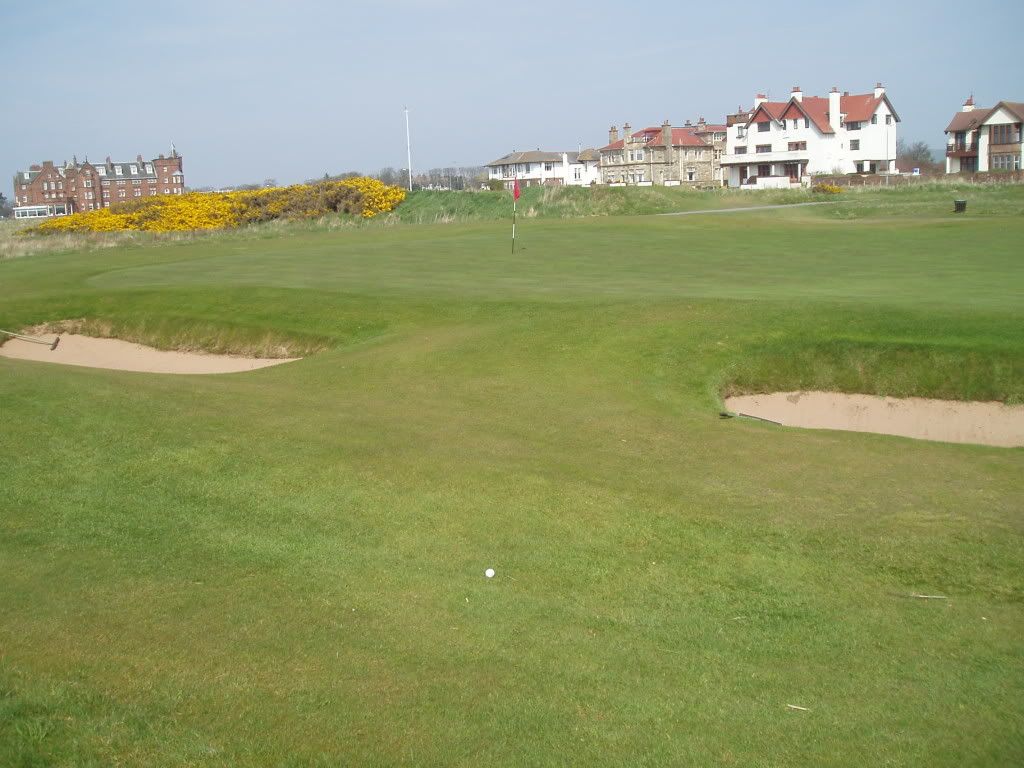
That advice does not apply to the final shot to the green! Silly me!
17th Rabbit 210 yards par 3
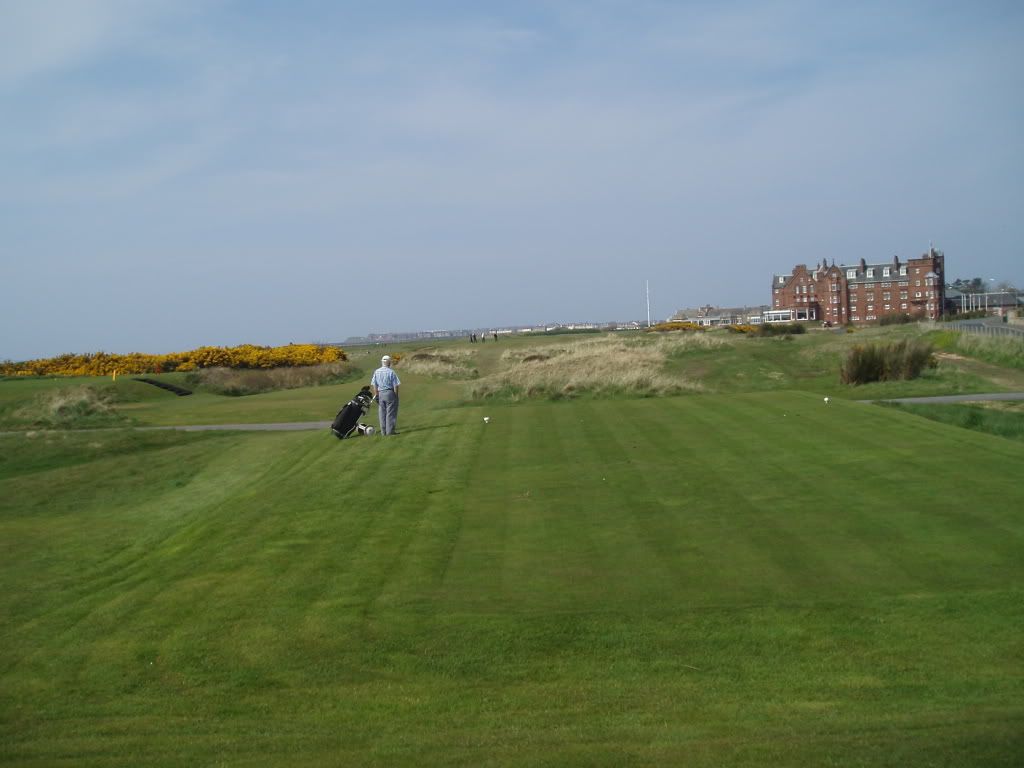
Yet another hole which reveals little from the tee.
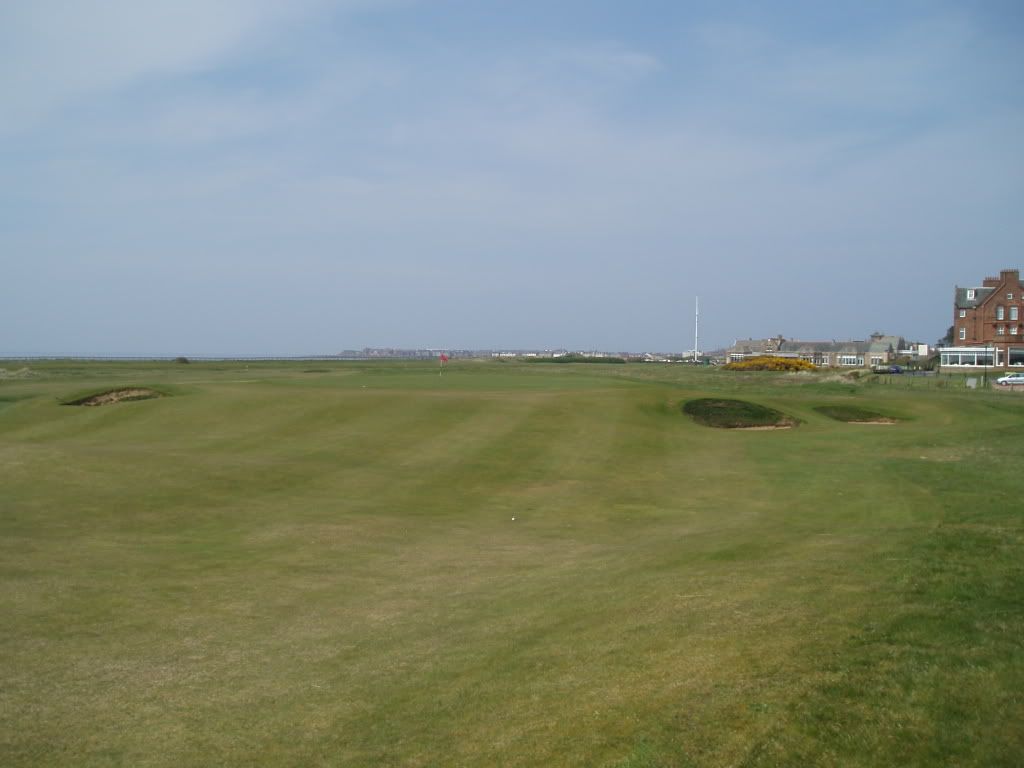
Yet again I underestimated the strength of the wind and came up woefully short. As you can see, the table-top green is well protected by its sloping sides and plentiful bunkers. You may notice a piece of white paper at the front of the green. It was supposed to indicate ‘nearest the hole’ for the 24 visitors who had been playing in fourballs in front of us. It gave me some comfort to find that they had written on the paper that nobody had hit the green – and they were playing from the yellow tees from which the hole is 167 yards long!
18th Craigend 374 yards par 4
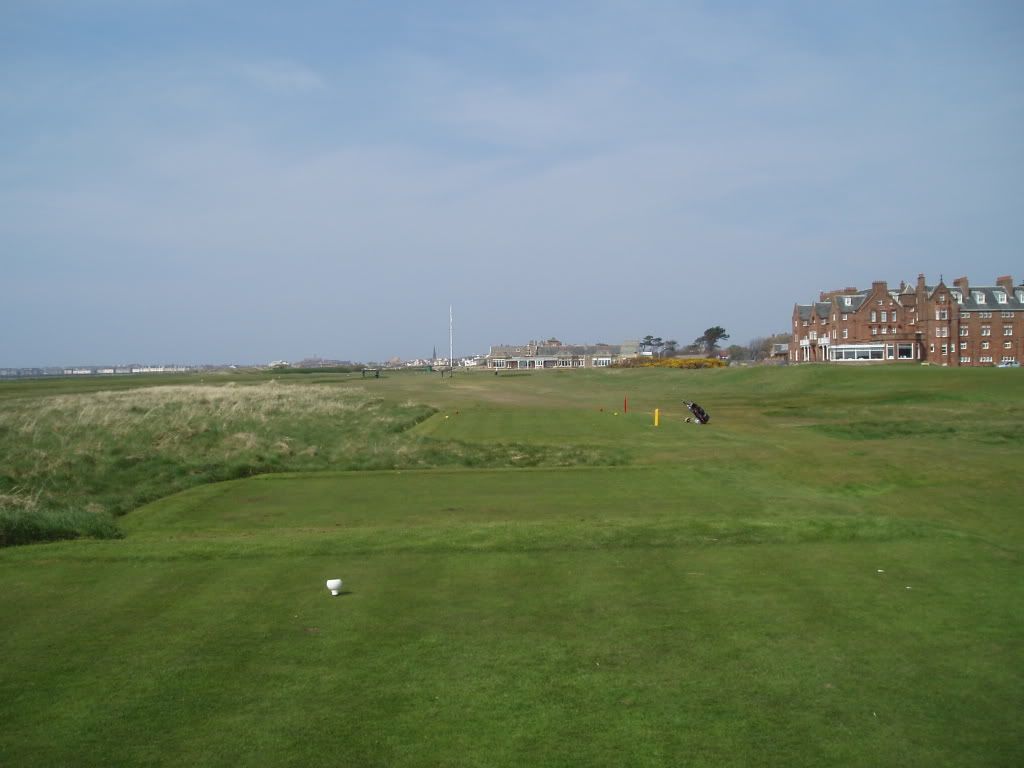
From the medal tee this is not too demanding a home hole as long as you keep out of the bunkers. From the championship tee it becomes a 457-yarder with bunkers on the left at 262, 290 and 326 yards out and one on the right at 307 yards. It was in the bunker on the right that Greg Norman’s challenge came to grief in the 3-way play-off for the 1989 Open. He had scored a record final round 64 to get into it.
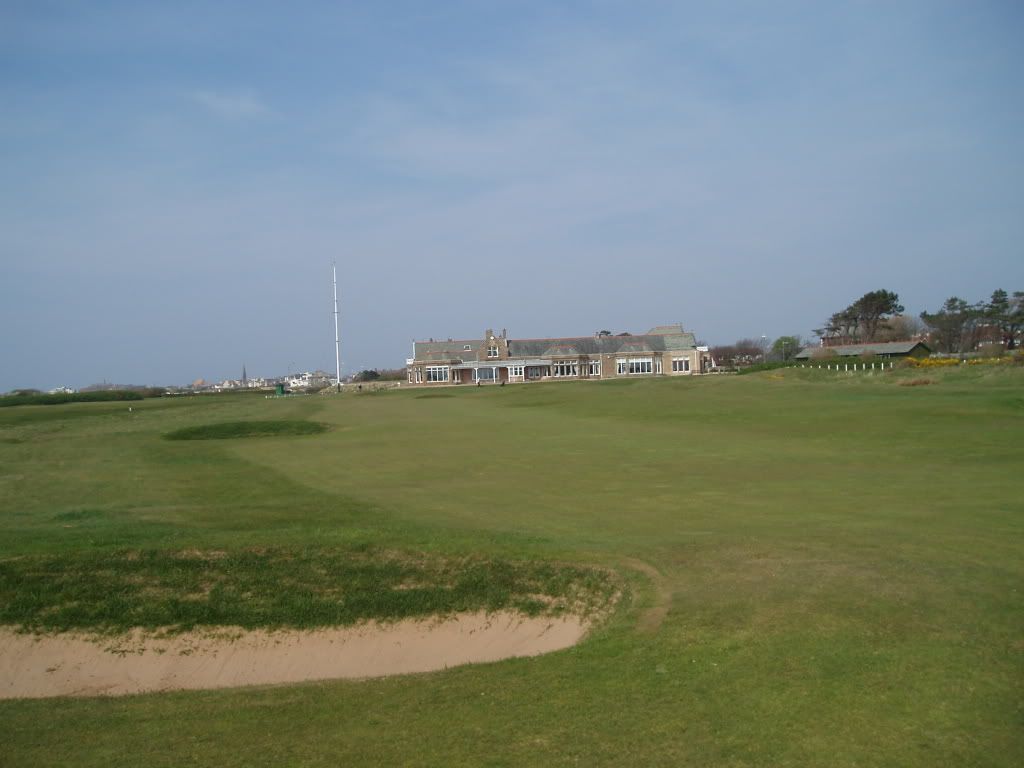
From here I have about 160 yards to the centre of the green. You can make out a number of what might be green-front bunkers or grassy hollows – there are both. There are bunkers left and right of the putting surface, too. But you cannot blast away unrestrained. Just through the back of the green is a gravel path. It is out-of-bounds.